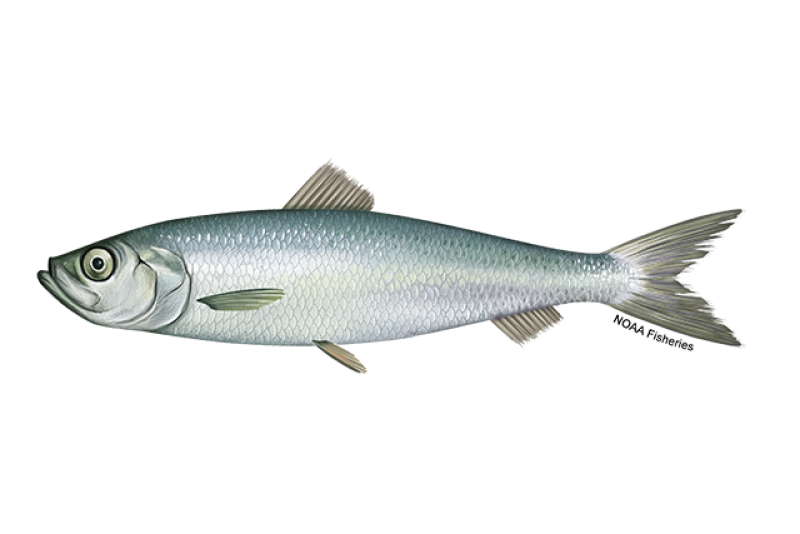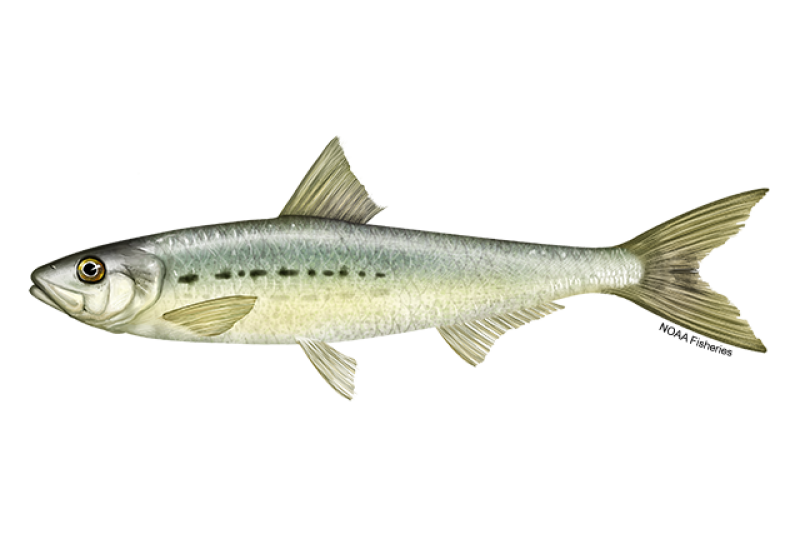Pacific Herring
Clupea pallasii
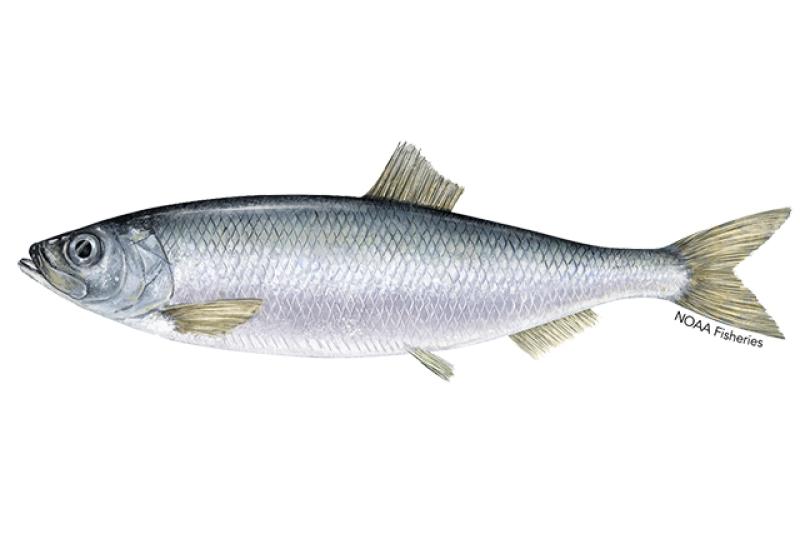
Quick Facts

About the Species

Pacific Herring is a coastal schooling species found on both the eastern and western sides of the Pacific Ocean. In the eastern North Pacific Ocean, Pacific Herring range from Beaufort Sea, Alaska, south to Baja California, Mexico.
Status
In February of 1999, we received a petition to designate Pacific Herring from Puget Sound, Washington, as a threatened or endangered species under the Endangered Species Act (ESA). In 2001, we found that listing Puget Sound Herring as threatened or endangered was not warranted because the population did not constitute a species, subspecies, or distinct population segment (DPS) under the ESA. However, we further determined that Puget Sound Pacific Herring, including the Cherry Point population, belonged to a larger group of Pacific Herring termed the Georgia Basin Pacific Herring DPS, and that this DPS was neither at risk of extinction, nor likely to become so.
In May 2004, a group of environmental organizations petitioned NOAA Fisheries to list the Cherry Point Pacific Herring population under the ESA. This population is called Cherry Point herring because of its location in Puget Sound, Washington. Cherry Point Pacific Herring numbers have been in decline since 1973. In June 2005, we announced that listing the Cherry Point Pacific Herring population under the ESA was not warranted because the population did not constitute a species, subspecies, or DPS under the ESA.
In 2007, we received a petition to designate the Lynn Canal population of Pacific Herring as a threatened or endangered DPS under the ESA. In 2008, we found that listing Lynn Canal Pacific Herring population as threatened or endangered under the ESA was not warranted because the population did not constitute a species, subspecies, or DPS under the ESA. However, we initiated a status review for a larger Southeast Alaska DPS (Dixon Entrance northward to Cape Fairweather and Icy Point). This DPS included all Pacific Herring populations in Southeast Alaska, including the Lynn Canal population. In 2014, we determined that listing the Southeast Alaska DPS of Pacific Herring under the ESA was not warranted.
Biology
Pacific Herring typically form large schools from the water's surface to depths of 1,300 feet. In addition to schooling, they use countershading for protection from predators. They are dark blue to olive on their backs and silver on their sides and belly, which makes them hard to see from above and below.
Maximum size, age at maturity, and longevity vary throughout the coast. Pacific Herring in southern locations (e.g., California) exhibit small size, mature earlier, and die younger. In contrast, Pacific Herring in the north (e.g., Bering Sea) obtain a far larger size at a similar age, mature later, and live longer. In Puget Sound, adult spawners range from 2-15 years in age; however, most are between ages 3 and 7. In the far northern Beaufort Sea, Pacific Herring can live 14-16 years and 18-20 years in the Bering Sea. Maximum length is 10 inches (26 cm) in Puget Sound, British Columbia, and the Beaufort Sea; 13 inches (34 cm) in the Bering Sea; and 9.5 inches (24 cm) in the Gulf of Alaska.
Adult Pacific Herring migrate into estuaries to breed once per year, with timing varying by latitude. They do not feed from the start of this migration through spawning, a period of up to two weeks. Pacific Herring spawn along shorelines in intertidal and shallow subtidal zones. They deposit their eggs on kelp, eelgrass, and other available structures. After spawning, herring return to their summer feeding areas.
After hatching, Pacific Herring larvae remain in nearshore waters close to their spawning grounds to feed and grow in the protective cover of shallow water habitats. After two to three months, the larvae metamorphose into juveniles. During the summer of their first year, these juveniles form schools in shallow bays, inlets, and channels. These schools disappear in the fall and then move to deep water for the next two to three years.
Pacific Herring feed on phytoplankton and zooplankton in nutrient-rich waters associated with oceanic upwelling. Young feed mainly on crustaceans, but also eat decapod and mollusk larvae. Adults prey mainly on large crustaceans and small fishes. Although some mixing occurs, tagging studies show that Pacific Herring stick together, remaining in the same school for years.
Scientific Classification
| Kingdom | Animalia | Phylum | Chordata | Class | Actinopterygii | Order | Clupeiformes | Family | Clupeidae | Genus | Clupea | Species | pallasii |
|---|
Last updated by NOAA Fisheries on 07/27/2023
Featured News
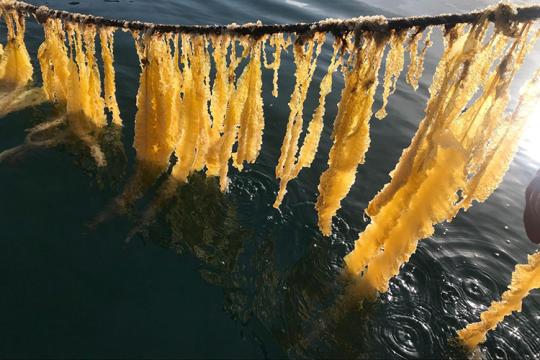 Herring roe on farmed ribbon kelp. Credit: Seagrove Kelp Company.
Herring roe on farmed ribbon kelp. Credit: Seagrove Kelp Company.
 Bryan Cormack, fisheries biologist at the Alaska Fisheries Science Center, uses a multi-channel pipette for streamlined high-throughput processing using the sulfo-phospho-vanillin (SPV) assay. He processed more than 2,700 SPV samples this past year. Credit: NOAA Fisheries/Cody Pinger.
Bryan Cormack, fisheries biologist at the Alaska Fisheries Science Center, uses a multi-channel pipette for streamlined high-throughput processing using the sulfo-phospho-vanillin (SPV) assay. He processed more than 2,700 SPV samples this past year. Credit: NOAA Fisheries/Cody Pinger.
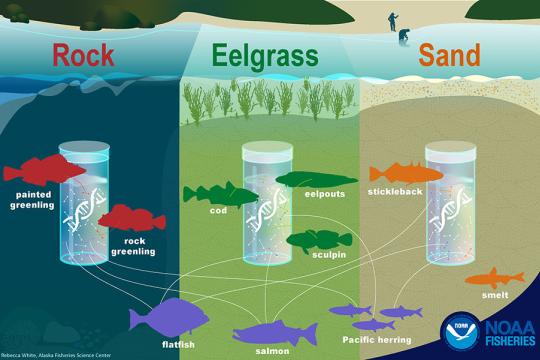 All organisms shed DNA into the environment. Environmental DNA (eDNA) can be used to determine the identities of the fish species that are present at or near the time of sample collection. Credit: NOAA Fisheries
All organisms shed DNA into the environment. Environmental DNA (eDNA) can be used to determine the identities of the fish species that are present at or near the time of sample collection. Credit: NOAA Fisheries
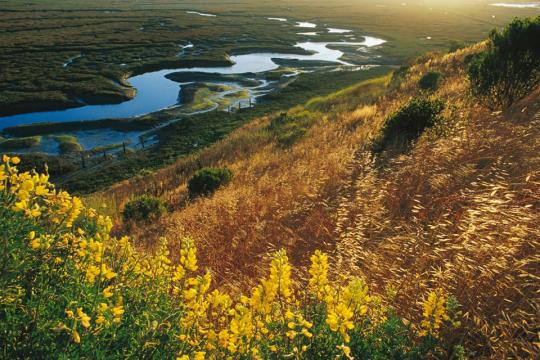 Elkhorn Slough meanders seven miles inland from Monterey Bay, California, harboring the largest tract of tidal salt marsh in California outside of San Francisco Bay. Credit: Elkhorn Slough National Estuarine Research Reserve
Elkhorn Slough meanders seven miles inland from Monterey Bay, California, harboring the largest tract of tidal salt marsh in California outside of San Francisco Bay. Credit: Elkhorn Slough National Estuarine Research Reserve
Celebrating 50 Years of Internationally Important Wetlands
Management Overview
Management in Alaska
Commercial and Subsistence Fisheries
Herring are a foundation species in Southeast Alaska, playing a central role in marine food webs and also of significant importance as a commercial and subsistence species in many communities.
Commercial fishing of Pacific herring in Southeast Alaska began during the late 19th century in the form of reduction fisheries—fisheries that "reduce" or turn their catch into fishmeal and fish oil. These essentially unregulated removals significantly reduced populations throughout the region until the industry closed in the 1960s. Current herring fisheries are managed by the Alaska Department of Fish and Game to ensure sustainability and include methods that target both adult fish and roe.
The commercial herring fishery in Lynn Canal and the Juneau area has been closed since 1982.
The Southeast Alaska Herring Management Plan for other spawning aggregates in Southeast Alaska requires that forecasted biomass estimates meet a designated minimum threshold, preset for each of the stocks, before commercial fishing is allowed. Harvest policies are then guided by a sliding-scale harvest rate between 10 and 20 percent. The maximum exploitation rate is 20 percent of the mature biomass, which is consistent with other herring fisheries on the west coast of North America. Learn more about the management of commercial herring fisheries in Southeast Alaska.
Herring population abundance trends are very dynamic and are subject to fairly substantial changes on both large and small geographic scales. Fluctuations in abundance are largely determined by marine conditions, which affect herring survival, growth, and recruitment. In Southeast Alaska, the Alaska Department of Fish and Game manages the herring fishery on a long-term, sustained yield basis. The agency monitors and manages several spawning aggregations within Southeast Alaska, including:
- Sitka
- Hoonah Sound
- Seymour Canal
- Hobart-Houghton
- Tenakee Inlet
- Ernest Sound
- West Behm Canal
- Craig
- Revilla Channel (Kah Shakes/Cat Island)
- Lynn Canal
Status Review
NOAA Fisheries conducted a status review of the Southeast Alaska distinct population segment of Pacific herring under the Endangered Species Act in 2014 and found that the species did not warrant listing.
In 2007, we received a petition to designate the Lynn Canal population of Pacific Herring as a threatened or endangered DPS under the ESA(PDF, 88 pages). In 2008, we found that listing Lynn Canal Pacific Herring population as threatened or endangered under the ESA was not warranted because the population did not constitute a species, subspecies, or DPS under the ESA. However, we initiated a status review for a larger Southeast Alaska DPS (Dixon Entrance northward to Cape Fairweather and Icy Point). This DPS included all Pacific Herring populations in Southeast Alaska, including the Lynn Canal population. In 2014, we determined that listing the Southeast Alaska DPS of Pacific Herring under the ESA was not warranted.
Management on the West Coast
Commercial Fisheries
Pacific Herring, which occurs in waters off California, Oregon, and Washington, is currently classified as an "ecosystem component species" in the Pacific Fishery Management Council's Coastal Pelagic Species (CPS) Fishery Management Plan. As an ecosystem component species, incidental catch of Pacific Herring in CPS fisheries is monitored and reported in the SAFE (Stock Assessment and Fishery Evaluation) CPS document.
- California - Historical aspects and current management of commercial fisheries for Pacific Herring in California are detailed in the California Pacific Herring Fishery Management Plan. Up until 2009, commercial harvest of Pacific Herring was allowed in ocean waters off California; however, directed commercial harvest of Pacific Herring in marine waters was banned beginning January 1, 2010. Currently, bycatch of Pacific Herring still occurs in fisheries for other coastal pelagic species but no more than 10% of any landing by weight can be Pacific Herring. This bycatch may be sold as bait or as animal feed. Pacific Herring spawn in numerous sheltered inlets, sounds, bays, and estuaries from San Diego Bay to Crescent City Harbor in California. However, only San Francisco Bay, Tomales Bay, Humboldt Bay, and Crescent City have spawning stocks abundant enough to have supported fisheries. Currently, over 90% of landings originate from San Francisco Bay. Pacific Herring are currently harvested for bait, fresh fish, and primarily for their roe, in the form of pre-spawn egg sacs. The products of this sac roe fishery have been mainly marketed in Japan.
- Oregon - Currently, commercial fishing for Pacific Herring is open all year in the marine waters of Oregon. Although Pacific Herring have been known to spawn in most coastal bays and estuaries in Oregon, they spawn regularly in Yaquina, Umpqua, and Coos bays, usually from February through early April. Bait fisheries for Pacific Herring are allowed in most bays and estuaries, but a state-managed limited-entry commercial Pacific Herring roe fishery is only allowed in Yaquina Bay, typically from January through April 15. Further details on Oregon's Pacific Herring fisheries are available in the 2019 ODFW Commercial Fisheries Regulations Synopsis.
- Washington - Historical aspects and current management of commercial fisheries for Pacific Herring in Washington are detailed in the Forage Fish Management Plan and the latest Washington State Herring Stock Status Report. Commercial fisheries for Pacific Herring in Puget Sound, prior to 1920, were conducted on or near the spawning grounds. The fish were mostly exported as a kippered and dry-salted product to Asian markets. From 1920 to the 1950s, the commercial Pacific Herring fisheries supplied bait for use in large commercial halibut, shark, crab, and cod fisheries, as well as in recreational salmon fisheries during the 1940s and 1950s. A general-purpose Pacific Herring fishery occurred in northern Puget Sound from 1956 to 1983 and most of the catch was used for bait, food for zoo animals, or reduced to meal and oil. Pacific Herring sac-roe (1973–1980) and spawn-on-kelp (1990–1996) commercial fisheries mainly operated on Pacific Herring from the Cherry Point population. Both of these later fisheries were eventually closed due to continued decreases in stock abundance. Currently, no directed Pacific Herring fishery harvest is allowed in Washington's coastal waters. In recent years, only commercial fishing for sport bait has been allowed in inland waters of Puget Sound. The sport bait fishery occurs primarily in south and central Puget Sound and primarily exploits 1.5-year-old Pacific Herring that are at the size preferred by recreational salmon fishermen. There are two coastal Washington stocks, Willapa Bay and Grays Harbor, which spawn from February through March. A small commercial bait fishery has operated on the Grays Harbor stock.
Previous Status Reviews under the ESA
NOAA Fisheries completed a status review of Pacific Herring in 2001. We initiated this status review in response to a petition received in February 1999 to list 18 species of marine fish in Puget Sound (Washington), including Pacific Herring. We concluded that the Pacific Herring stocks in Puget Sound do not qualify as a "species" under the Endangered Species Act. We determined that these Puget Sound Pacific Herring stocks, including Cherry Point, belonged to a larger group of Pacific Herring. This larger group, called Georgia Basin Pacific Herring DPS, consists of more than 40 inshore stocks from Puget Sound and the Strait of Georgia in the U.S. and Canada.
We concluded that the Georgia Basin Pacific Herring DPS does not warrant listing under the ESA. However, we did note concern about two Pacific Herring stocks within the Georgia Basin (the Cherry Point and Discovery Bay stocks) that have shown marked declines in range and abundance. We recognized that these two declining stocks may be vulnerable to extirpation, but concluded that they represent a relatively small portion of the Georgia Basin DPS and do not confer significant risk to Pacific Herring in the Georgia Basin.
Reason for the 2006 Status Review
In 2004, we received two petitions, one in January and a supplemental petition in May, from the Northwest Ecosystem Alliance and six co-petitioners to find that the Cherry Point Herring population qualifies as a species under the ESA and warrants listing as a threatened or endangered species.
On August 10, 2004, we issued our finding that the petition received in January 2004 failed to present substantial scientific and commercial information indicating that the petitioned action may be warranted. However, we found that the petition received on May 14 did meet those criteria. As part of this finding, we announced that we would conduct a thorough review of the species' status, and solicited information pertinent to that review.
Qualified Species
Under the ESA, a listing determination may address a species, subspecies, or a distinct population segment of any vertebrate species that interbreeds when mature (section 3(16)).
On February 7, 1996, the U.S. Fish and Wildlife Service and NOAA Fisheries adopted a policy to clarify the agencies' interpretation of the DPS provision for the purposes of listing, delisting, and reclassifying a species under the ESA. The joint DPS policy identified two elements that must be considered when making DPS determinations:
- The discreteness of the population segment in relation to the remainder of the species (or subspecies) to which it belongs.
- The significance of the population segment to the remainder of the species (or subspecies) to which it belongs.
ESA "Species" of Pacific Herring
We considered several alternative DPS configurations for Pacific Herring that incorporated the Cherry Point stock. They ranged from the previously identified Georgia Basin DPS to a DPS encompassing Pacific Herring from San Diego to Sitka, Alaska. We concluded that the available information was not sufficient to warrant modification of the previous DPS delineation. Evidence supports the finding that Georgia Basin Pacific Herring satisfy the criteria for discreteness and significance under the joint DPS policy, including:
- Similarity in age composition of Pacific Herring in the Strait of Georgia and Puget Sound supporting discreteness of Georgia Basin Pacific Herring.
- Ecological uniqueness of the inshore waters of Puget Sound and the Strait of Georgia supporting the significance of Georgia Basin Pacific Herring to the taxon as a whole.
The Georgia Basin DPS encompasses spawning stocks of Pacific Herring in the marine waters of Puget Sound, the Strait of Georgia, and eastern Strait of Juan de Fuca in the U.S. and Canada. Subsequent to the delineation of this DPS in 2001, the area known as the Georgia Basin was officially designated as the "Salish Sea" by the United States Board on Geographic Names in 2009 and by the British Columbia Geographical Names Office in 2010 to honor the local indigenous peoples, the Coast Salish.
Reasoning for Not Listing Cherry Point Herring Under the ESA
In 2005, we concluded that the Cherry Point stock is "discrete" under the DPS policy, but that it does not satisfy the applicable DPS criteria for "significance." Cherry Point Pacific Herring are not "significant," and so do not qualify as a DPS for ESA listing because:
- Cherry Point does not represent a unique or unusual ecological setting for Pacific Herring.
- Loss of Cherry Point Pacific Herring would not result in a significant gap in the extensive range of Pacific Herring.
- The Cherry Point stock does not exhibit "marked" genetic differentiation relative to other Pacific Herring populations.
Reasoning for Not Listing Georgia Basin DPS of Pacific Herring Under the ESA
In 2006, we concluded that the Georgia Basin DPS of Pacific Herring is not threatened or endangered, and does not warrant ESA listing. The overall abundance of the DPS was at historically high levels, and the extent of coastline used for spawning had increased. The available information suggests that spawning stocks in the Georgia Basin DPS operate as a "metapopulation." This means that all subpopulations are connected by migration, but some are relatively discrete, with weaker linkages to other subpopulations in the DPS. In a viable metapopulation, we can expect some local subpopulations to be in decline, other subpopulations to increase, and some suitable habitat patches to be unoccupied.
The decline of some local stocks (principally the Cherry Point stock, and the non-migratory inlet stocks in the eastern Strait of Georgia) is not by itself cause for concern about the long-term viability of the DPS. The few declining stocks represent a small proportion of the more than 40 stocks and assessment areas that comprise the Georgia Basin DPS.
Evidence of significant migration among stocks, high levels of gene flow, and disappearance and subsequent recolonization events for Georgia Basin Pacific Herring suggest that local extirpations or stock declines provide little risk to the overall DPS.
Key Actions and Documents
2019 – IUCN Red List Assessment of Pacific Herring
Alaska
2014 – NOAA Fisheries determined that listing the Southeast Alaska DPS of Pacific Herring under the Endangered Species Act was not warranted (79 FR 18518).
- Announcement of Listing Determination/Not Warranted
- Status Review of Southeast Alaska Herring (PDF, 177 pages)
- Summary of Peer Reviewer Comments and Response for the Status Review of Southeast Alaska Herring (PDF, 7 pages)
2008 – NOAA Fisheries found that listing Lynn Canal Pacific Herring as threatened or endangered under the ESA was not warranted because the population did not constitute a species, subspecies, or DPS under the ESA. However, NOAA Fisheries initiated a status review for a larger Southeast Alaska DPS (Dixon Entrance northward to Cape Fairweather and Icy Point) which included all Pacific Herring stocks in Southeast Alaska, including the petitioned Lynn Canal population (73 FR 19824).
- Status Review of Lynn Canal Pacific Herring (PDF, 155 pages)
2007 – NOAA Fisheries received a petition (PDF, 88 pages) to designate the Lynn Canal stock of Pacific Herring as a threatened or endangered distinct population segment under the ESA.
West Coast
2006 – The Biological Review Team determined that the Cherry Point herring stock does not qualify as a "species" for consideration under the ESA, and the DPS to which the Cherry Point belongs—the Georgia Basin Pacific herring DPS—is not at risk in all or a significant portion of its range.
- June 2006 – Status Review of Cherry Point Pacific Herring
2005 – NOAA Fisheries determined that the Cherry Point herring stock does not qualify as a "species" for consideration under the ESA. The Biological Review Team determined the Georgia Basin Pacific herring DPS is not at risk in all or a significant portion of its range.
- June 7, 2005 – Federal Register Notice
- June 6, 2005 – News release
- January 24, 2005 – Herring Status Review Summary (PDF, 33 pages)
2004 – NOAA Fisheries initiates a status review of the Cherry Point Pacific Herring.
- August 10, 2004 – Federal Register notice
- May 14, 2004 – Supplemental Petition to List Herring (PDF, 36 pages).
- January 21, 2004 – Petition to List Herring January 2004 Petition to List Herring (PDF, 52 pages).
2001 – NOAA Fisheries determined that the Puget Sound Pacific Herring stock does not qualify as a "species" for consideration under the ESA. The Biological Review Team delineated a Georgia Basin Pacific Herring DPS, which includes Puget Sound stocks of Pacific Herring, and concluded, by a large majority, that this Georgia Basin DPS of Pacific Herring is neither at risk of extinction nor likely to become so.
- April 3, 2001 – Federal Register Notice (66 FR 17659)
- March 2001 – Herring Status Review
1999 – NOAA Fisheries initiates a status review of Pacific Herring in Puget Sound, Washington
- June 21, 1999 – Federal Register Notice (64 FR 33037)
- February 8, 1999 – Petition to list Pacific Herring and 17 other marine fish species in Puget Sound
Last updated by NOAA Fisheries on 07/27/2023
Documents
Supplemental Information for NMFS’s Temporary Rule and Modification of Closure of the Summer Herring Savings Area 2 in the Bering Sea Subarea of the BSAI
Herring prohibited species catch (PSC) in the Bering Sea and Aleutian Islands management area…
Status Reviews of Non-Marine Mammals in Alaska
Status reviews of non-marine mammals considered for Endangered Species Act (ESA) listing as…
Endangered Species Act Status Review of Cherry Point Pacific Herring (Clupea pallasii) and Updated Status Review of Georgia Basin Pacific Herring Distinct Population Segment
A 2006 status review report conducted on a petitions seeking to list Pacific herring that spawn at…
Environmental Assessment/Regulatory Impact Review/Initial Regulatory Flexibility Analysis for Amendment 16a to the FMP for Groundfish of the Bering Sea and Aleutian Islands
Analysis of halibut and crab bycatch management measures, and the implementation of herring bycatch…
Last updated by NOAA Fisheries on 07/27/2023
